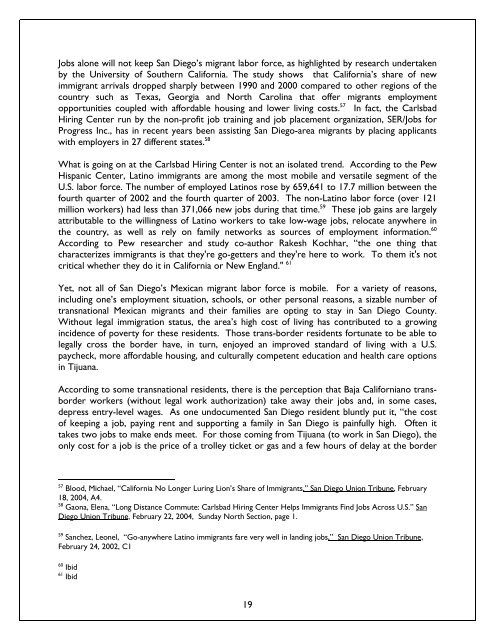Blurred Borders - International Community Foundation
Blurred Borders - International Community Foundation
Blurred Borders - International Community Foundation
You also want an ePaper? Increase the reach of your titles
YUMPU automatically turns print PDFs into web optimized ePapers that Google loves.
Jobs alone will not keep San Diego’s migrant labor force, as highlighted by research undertaken<br />
by the University of Southern California. The study shows that California’s share of new<br />
immigrant arrivals dropped sharply between 1990 and 2000 compared to other regions of the<br />
country such as Texas, Georgia and North Carolina that offer migrants employment<br />
opportunities coupled with affordable housing and lower living costs. 57 In fact, the Carlsbad<br />
Hiring Center run by the non-profit job training and job placement organization, SER/Jobs for<br />
Progress Inc., has in recent years been assisting San Diego-area migrants by placing applicants<br />
with employers in 27 different states. 58<br />
What is going on at the Carlsbad Hiring Center is not an isolated trend. According to the Pew<br />
Hispanic Center, Latino immigrants are among the most mobile and versatile segment of the<br />
U.S. labor force. The number of employed Latinos rose by 659,641 to 17.7 million between the<br />
fourth quarter of 2002 and the fourth quarter of 2003. The non-Latino labor force (over 121<br />
million workers) had less than 371,066 new jobs during that time. 59 These job gains are largely<br />
attributable to the willingness of Latino workers to take low-wage jobs, relocate anywhere in<br />
the country, as well as rely on family networks as sources of employment information. 60<br />
According to Pew researcher and study co-author Rakesh Kochhar, “the one thing that<br />
characterizes immigrants is that they're go-getters and they're here to work. To them it's not<br />
critical whether they do it in California or New England." 61<br />
Yet, not all of San Diego’s Mexican migrant labor force is mobile. For a variety of reasons,<br />
including one’s employment situation, schools, or other personal reasons, a sizable number of<br />
transnational Mexican migrants and their families are opting to stay in San Diego County.<br />
Without legal immigration status, the area’s high cost of living has contributed to a growing<br />
incidence of poverty for these residents. Those trans-border residents fortunate to be able to<br />
legally cross the border have, in turn, enjoyed an improved standard of living with a U.S.<br />
paycheck, more affordable housing, and culturally competent education and health care options<br />
in Tijuana.<br />
According to some transnational residents, there is the perception that Baja Californiano transborder<br />
workers (without legal work authorization) take away their jobs and, in some cases,<br />
depress entry-level wages. As one undocumented San Diego resident bluntly put it, “the cost<br />
of keeping a job, paying rent and supporting a family in San Diego is painfully high. Often it<br />
takes two jobs to make ends meet. For those coming from Tijuana (to work in San Diego), the<br />
only cost for a job is the price of a trolley ticket or gas and a few hours of delay at the border<br />
57<br />
Blood, Michael, “California No Longer Luring Lion’s Share of Immigrants,” San Diego Union Tribune, February<br />
18, 2004, A4.<br />
58<br />
Gaona, Elena, “Long Distance Commute: Carlsbad Hiring Center Helps Immigrants Find Jobs Across U.S.” San<br />
Diego Union Tribune, February 22, 2004, Sunday North Section, page 1.<br />
59<br />
Sanchez, Leonel, “Go-anywhere Latino immigrants fare very well in landing jobs,” San Diego Union Tribune,<br />
February 24, 2002, C1<br />
60 Ibid<br />
61 Ibid<br />
19















